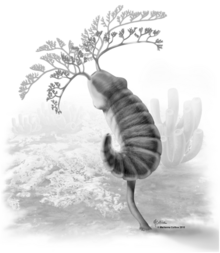| Cambroernids Temporal range:
| |
|---|---|

| |
| Herpetogaster | |

| |
| Eldonia | |
| Scientific classification | |
| Domain: | Eukaryota |
| Kingdom: | Animalia |
| Stem group: | Ambulacraria |
| Clade: | †Cambroernida Caron, Conway Morris, & Shu, 2010 |
| Subdivisions | |
The cambroernids are a clade of unusual Paleozoic animals with coiled bodies and filamentous tentacles. They include a number of early to middle Paleozoic (Cambrian to Devonian)[1] genera noted as "bizarre" or "orphan" taxa, meaning that their affinities with other animals, living or extinct, have long been uncertain. While initially defined as an "informal stem group,"[2] later work with better-preserved fossils has strengthened the argument for Cambroernida as a monophyletic clade.[3]
One leading hypothesis is that cambroernids were unusual ambulacrarian deuterostomes, related to echinoderms and hemichordates.[2] Previously some cambroernids were compared to members of the broad invertebrate clade Lophotrochozoa; in particularly they were allied with lophophorates, a subset of lophotrochozoans bearing ciliated tentacles known as lophophores.[4] However, this interpretation has more recently been considered unlikely relative to the deuterostome hypothesis for cambroernid origins.[2]
Cambroernids encompass three particular types of enigmatic animals first appearing in the Cambrian: Herpetogaster (the type genus), Phlogites, and the Eldonioidea. They are united by a set of common features including at least one pair of bifurcated or divided oral tentacles, and a large stomach and narrower intestine enclosed together in a coiled sac. Herpetogaster has a segmented and clockwise-curved body attached to the substrate via a narrow and partially mobile stolon (stalk). Phlogites was even more simple, with a thick immobile stolon leading up to a tentacle-bearing calyx (cup-shaped main body). The eldoniids[2][5] (also known as eldonioids[4][6][7] or eldonids[1][6]) were diverse and disc-shaped, commonly described as "medusiform", i.e. jellyfish-shaped. Though the lifestyle of eldoniids is still debated, it can be agreed that they had a large curved stomach and no stolon.[4][2][8][6]